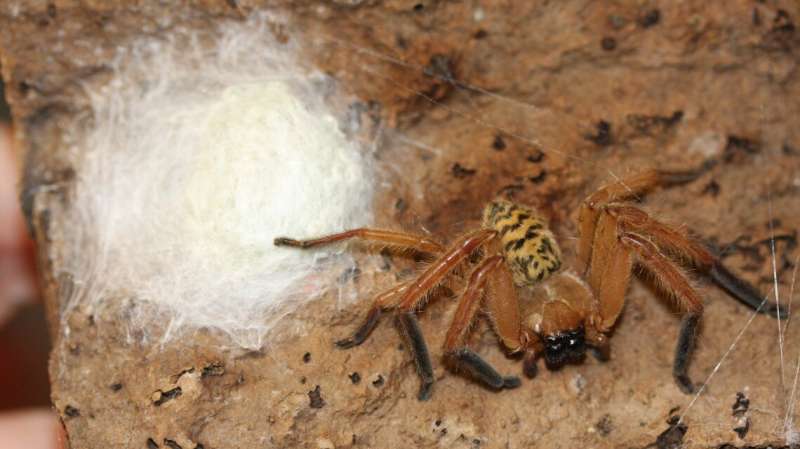[ad_1]

A new study of huntsman spiders inbound links evolutionary lineages with existence historical past attributes, giving designs for predicting social behaviors in other a lot less-studied species. Sociality is very rare in spiders—only five out of shut to 1,300 huntsman species are recognised to exhibit social behaviors.
The examine released June 2 in the journal Molecular Phylogenetics and Evolution was portion of the undergraduate thesis of lead creator Jacob Gorneau ’20.
It represents the broadest and most in-depth phylogeny of huntsman spiders—a tree-like diagram displaying evolutionary relatedness between groups of organisms—while incorporating comprehensive biology and daily life record knowledge for every species. When compared with solitary species, the findings reveal, the social species reside in larger sized long-lasting family team retreats right up until the offspring are up to a year outdated, have egg sacs plastered to surfaces so they won’t be able to be moved and start off foraging later on in their enhancement.
“The social species are undertaking something various than all the other solitary species,” said Linda Rayor, the paper’s senior writer and a senior research associate in the Division of Entomology in the University of Agriculture and Life Sciences (CALS).
“What makes this a landmark examine is that we have included behavioral and daily life-record qualities on huntsman that I have been accumulating for the final 20 decades from each social and solitary species,” she said.
Huntsman spiders (Sparassidae spouse and children) are relatively popular all over the tropics and subtropics all over the world. They are also exceptionally numerous, with Sparassidae, the 11th most significant spider loved ones, courting again 100 million several years.
The acknowledged social species span two genera and include four from Australia (Delena cancerides, D. lapidicola, D. melanochelis, and D. spenceri) and an unknown species (Damastes) discovered in Madagascar. These social species live in massive loved ones teams with a one mom and several clutches of her offspring in retreats beneath the unfastened bark of lifeless trees or under rocks. The expanding offspring continue being in their natal retreat for 5 to twelve months, dependent on the species.
The social species were being also identified to have egg sacs plastered to the back again of retreats, so they could not be moved, all of which encourage residing socially in excess of extended intervals in family members groups. In contrast, the solitary species are extra cell and don’t have big, extensive long lasting retreats, so offspring don’t stay with their mom for extended than a handful of weeks.
It is approximated that at the very least 1,000 huntsman species stay to be explained. Anecdotal evidence suggests other species in a variety of pieces of the environment may perhaps also be social, as researchers have witnessed mother huntsman spiders living in retreats with lots of instars (phases of larvae improvement) of offspring that share prey.
“There are in all probability a selection additional of these fairly social huntsman spiders, and this review offers a guide to search for identical lifestyle-record qualities to see if they are also social,” Rayor said.
In the research, the researchers analyzed 271 spiders (262 were huntsman spiders, and nine have been other types of spiders employed for comparison), covering 37 genera and eight of the 11 sparassid subfamilies and involved lifetime background facts for 40 species, centered on laboratory and subject observations collected by Rayor between 2002 and 2021. Gorneau also sequenced four genes to deliver a properly-rounded photo of huntsman spider evolution.
“Some genes evolve extra quickly and are fantastic for examining dissimilarities concerning a lot more carefully similar species, while some genes evolve a lot more slowly—are a lot more conserved—and are improved for comprehending evolutionary interactions concerning groups of species that might be more distantly related. So we selected four genes that struck the appropriate balance,” stated Gorneau, who worked in Rayor’s lab and in the lab of co-author Corrie Moreau, the Martha N. and John C. Moser Professor of Arthropod Biosystematics and Biodiversity and director and curator of the Cornell University Insect Selection.
In future operate, Rayor and colleagues are scheduling a comparative investigation of prey-sharing in 29 social and solitary huntsman species that will use this new phylogeny.
New spider species named right after Greta
Jacob A. Gorneau et al, Huntsman spider phylogeny informs evolution of daily life historical past, egg sacs, and morphology, Molecular Phylogenetics and Evolution (2022). DOI: 10.1016/j.ympev.2022.107530
Quotation:
Examination of huntsman spiders reveals patterns of social actions (2022, June 6)
retrieved 15 June 2022
from https://phys.org/news/2022-06-assessment-huntsman-spiders-reveals-patterns.html
This document is topic to copyright. Aside from any honest dealing for the function of non-public examine or analysis, no
element may possibly be reproduced without the prepared authorization. The content is provided for data applications only.
[ad_2]
Resource backlink


More Stories
How Social Sciences Shape Our Modern World
Why Social Sciences Matter More Than Ever
The Hidden Power of Social Sciences in Policy Making